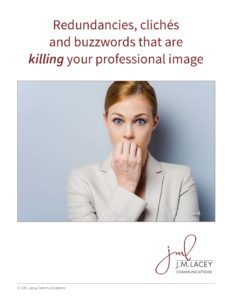Most of us have this in our home: the statement from a company printed on its product that “4 out of 5 dentists” use this; or a statement from the media or other sources that “1 out of 10 people” will experience this; “36 percent of people” agree with this; or “research suggests” this.
When marketing to consumers, companies rely on this tactic to gain instant trust so we will be swayed by questionable testimony to buy that product.
But when consumers – who have psychologically convinced themselves the marketing must be correct because the company or social media told them it was true – learn they were lied to and fell for the scam, they are devastated. On the flip side, there are many people who do their research and realize these statements are inaccurate and share their findings with others.
Even when communicating internally, we have to scrutinize our own statements and comments to make sure they are accurate. If our opinion is given as fact, we are misapplying information, or simply communicating a message we think others want to hear, the deceit will eventually come to light with dire consequences.
Is accuracy in business that important? How does accuracy affect our business relations? What sources can you trust for correct information?
Why accuracy is important
No one wants to be lied to. But sometimes, although people do not intend to lie, when they supply inaccurate information, that is precisely the result.
As a company, one of your goals is to build trust among your consumers and your employees. Consumers who trust you will continue to buy from you. Employees who trust you, who believe in what you represent, will be loyal to you.
Be certain that your communications are solid with key facts, sound logic, and trusted research. You can build confidence in your employees when they see – and experience – that you have done your homework.
You want to position yourself as an expert with your particular service and/or products. Be open about your sources of information to do this. For example, many of my articles include references to psychology professionals and other sources of business education. This is important so my readers understand that the information I am relating to them comes from experts and unbiased, trusted sources.
You know how deep your trust runs when you experience loyalty despite setbacks. Unfortunately, no one is immune to mistakes, including businesses. But the organizations that bounce back are the ones who have built a loyal following and continue to maintain that. These businesses are open with their policies and errors, are accountable, and take swift action to fix any issues.
Above all, accurate information plays a key role in
solidifying trust.
Where is accuracy important?
When we discuss accuracy here, we are referring to marketing, documents, reports and communications, both external and internal, which reveal anything that is a statement of fact.
The World Book Encyclopedia defines accuracy as: “the state of being without errors or mistakes; exactness; correctness; precision.”
Accuracy involves true statements; deep study; correct spelling and grammar according to the culture or nationality of the source, location and time period; and irrefutable proof. Accurate statements are free of bias and opinion.
For example, when you say “4 out of 5” dentists approve a product, who are those dentists? Did they receive payment from the company for trying or testing the product? A statement such as this needs convincing proof and evidence there is no bias. And stating that something has been “researched” does little for the claim without revealing the source of that research.
When numerical figures are used, these have to be checked. When quotes are used, these also need to be checked as sometimes, especially over a period of time and multiple sources, quotes can be misapplied or incorrectly credited.
What this means: We have been conditioned to dispel information at a rapid pace. However, if accuracy is our top goal in communications, this will require more time to check our facts and sources. It is better to take additional time and effort to be accurate and honest than to have to recant our statement and suffer the loss of trust. Rebuilding trust takes more time and our reputation may never fully heal.
What sources are trustworthy?
Whenever you use a source, whether a living source or written material, make sure you know the source’s background and motive. Some sources are biased and will lean in a particular direction when delivering information. Review the source, the “about” page if it’s on a website, background information and what or who the source represents.
When you are referencing a quote or other snippets of information, for example, make sure you read the article (or source) in its entirety to be clear that you do not misapply the quote or snippet. When comments are taken out of context, this is misleading and untruthful.
If you alter text or quotes in any way, you need to be upfront about this.
The best sources to consult are books, particularly ones that have a multitude of editors, undergo a strict review process, and remain neutral. For example, the World Book Encyclopedia.
Living sources are good. However, memory can lapse or be skewed depending on the person, his age, etc. You will still need to check dates and other information given to be certain that what the person told you is correct.
Magazines and newspaper articles are a good reference, but be wary about using the information as fact as the author may not have been as precise in cross-checking information as he/she should have been.
Case in point: A few years ago, I wrote a series of articles for a magazine on historic homes in the area I lived at the time. When doing my research for one in particular, I reviewed old newspaper articles as well as books documenting the area’s history. The information I continued to see referred to this particular home in a certain architectural style. Knowing many historic styles as I do, this did not seem to be correct as the home was missing many of the elements of this style. I cross-checked references to Victorian architecture that clarified what I knew. Then when I located a good source that quoted the architect saying that he “hated” that specific style and would never dream of building anything in that style, I knew that all the other references were incorrect. The earliest reference (1950s) was from the local newspaper and all references repeated (word-for-word in some cases) that newspaper writer’s incorrect description through the following decades. The magazine editor who hired me was hesitant with my updated architectural style reference as it went against popular opinion; however, with all the trusted evidence I presented to her, she ran my article as it was.
The point here is when you have irrefutable evidence from trusted sources, regardless of previous so-called “facts,” it is better to lean on proof as opposed to popular opinion. This will give you more confidence and stabilize the trust you need from others as they look to you as a reliable authority.
With regard to online information, while that can be a jumping-off point to gather material, this is the least trustworthy source of accurate information. Many sites cater to popular opinion, are not reviewed or monitored by established professionals or experts, are sometimes edited by multiple sources, have an agenda, or are simply untrustworthy because you do not have access to the source. You do not know the person, the reputation or the credentials of the site owner.
When reviewing your own company’s timeline and history, you also need to make sure your information is accurate. Human error happens, and it continues until someone notices a problem. Let that be you.
And finally, always cross-check your information. Never rely on one origin, but review multiple sources to make sure your information is accurate.
Tell us: What sources do you find trustworthy for your information? What are some ways you check the accuracy of your information?

Want to know what words are killing your professional image?
Download your Free report.
You’ll also receive “Creative Corporate Communications,” a monthly alert to help you build trust in your organization.


Recent Comments